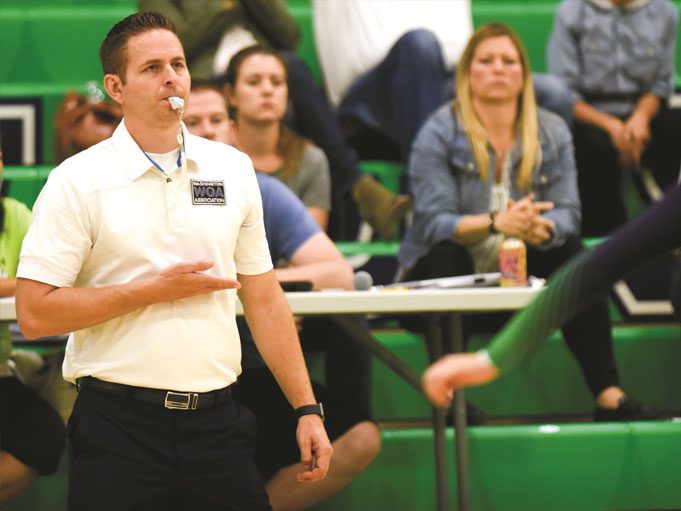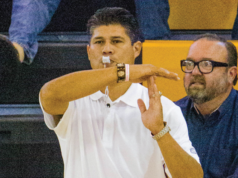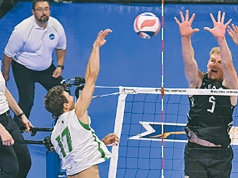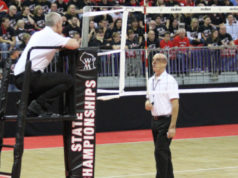The duties of the first and second referees are delineated in the rulebook. In the best of cases, this division of duties ensures that, between them, the referees are able to judge the legality of each contact of every rally throughout a match.
However, the reality is that there are times that one of the referees witnesses infractions outside his or her primary area of responsibility. For the second referee, this problem can be overcome by the use of discreet signals, used to give input to the first referee. Most first referees are quite willing to consider assistance offered by the other members of the team since, by rule, they have final authority over all decisions. But what about the situations where the first referee should make a call that “belongs” to the second referee? Are there any occasions where the second referee should make a call that “belongs” to the first referee? What are the consequences of making these calls?
There are three easy examples that come to mind where the first referee could whistle a fault that is a primary responsibility for the second referee.
Net fault
The simplest example is a net fault, especially when the fault is on a blocker close to the first referee. Sometimes, the second referee is screened from this fault by the arms and bodies of the blockers. When the first referee makes this call, there is strong likelihood of establishing or improving the participants’ confidence in the officiating crew. It is a common practice for the first referee to hesitate for just a second to give the second referee the opportunity to make the call, and then whistle it if needed.
Centerline faults
Although infrequent, there are times that the first referee can see a centerline fault, but should he or she whistle that fault, taking the call away from the second referee? The first referee cannot consistently pay attention to the centerline, as his or her primary focus should typically be elsewhere. And in the rules codes where some encroachment situations can be judged as legal, the first referee might not know the other centerline judgments that the second referee has made previously. As a result, there is a risk to the officiating crew’s credibility when the first referee makes this call. However, if the first referee is certain that a centerline fault occurred, it is appropriate to give the second referee a second to make the call, and then whistle the fault if necessary to get the call right.
Alignments
Position faults on the receiving team present a challenge for the first referee. There are times the view from the referee stand allows the first referee to see these positional faults differently (or better) than the second referee can from the floor. Current training is to have the first referee discreetly signal/indicate to the second referee that there is a receiving team position fault. But what if the second referee does not see the discreet signal or does not see the fault? In order to whistle the position fault, the first referee must be absolutely sure of the fault, and since the first referee is obliged to watch the contact of serve, he or she must be certain that the receiving team remains out of position at the time of service contact. If the first referee makes this call, the second referee is put in the position of having to explain or defend the call, as well as explain the reason that the second referee did not make the call. This particular call can have a significant negative impact on the credibility of the officiating crew, particularly in how the coaches view the competence of the second referee. This might be a topic for the prematch discussion so that the referees have discussed how to best get this call right.
Pancakes
For the second referee, sometimes discreet signals are not enough when assistance is needed for a call that is the first referee’s primary responsibility. The classic example is whether a pancake attempt is successful or not. Many second referees cover this situation in the prematch conference with the first referee by saying, “I will signal the ball down and give you a chance to whistle it. If you do not whistle (unless you wave me off), I will whistle the play dead if I am absolutely certain the ball hit the floor.” The first referee usually agrees with this since the second referee will need to own the call and explain it to the coaches. When the second referee makes this call, there is strong likelihood of establishing or improving the participants’ confidence in the officiating crew.
Attack line
Faults involving the attack line are another area where the second referee could, in certain circumstances, consider going beyond discreet signals. Current training instructs the second referee to note the location of the foot near the attack line, and if a fault is observed, the second referee should give a discreet signal to the first referee. If the play is especially quick, or the second referee is screened from the first referee, the second referee can whistle to end the rally. For that to occur, there should be no doubt as to the ball being completely above the height of the net, and it should be extremely obvious that the player’s foot encroached past the attack line. In these situations, it is better to stop the rally near the time the fault occurs rather than wait until the rally ends and potentially have to change the result.
Modern volleyball places an emphasis on getting the calls right. Video challenge systems are in place at the highest levels to eliminate any major missed calls. In that same spirit, there are times when one referee could make a call outside his or her normal duties. Done wisely, participants and spectators alike will appreciate the correct call being made in a timely manner.
What's Your Call? Leave a Comment:
Note: This article is archival in nature. Rules, interpretations, mechanics, philosophies and other information may or may not be correct for the current year.
This article is the copyright of ©Referee Enterprises, Inc., and may not be republished in whole or in part online, in print or in any capacity without expressed written permission from Referee. The article is made available for educational use by individuals.


















